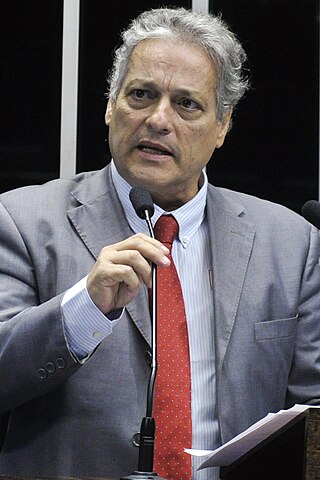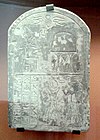
Porto Alegre–Salgado Filho International Airport is the airport serving Porto Alegre and the region of Greater Porto Alegre, Brazil. Since October 12, 1951, it is named after the Senator and first Minister of the Brazilian Air Force Joaquim Pedro Salgado Filho (1888–1950).

Progressistas is a centre-right to right-wing political party in Brazil. Founded in 1995 as the Brazilian Progressive Party, it emerged from parties that were successors to ARENA, the ruling party of the Brazilian military dictatorship. A pragmatist party, it supported the governments of presidents Fernando Henrique Cardoso, Luiz Inácio Lula da Silva, Dilma Rousseff, Michel Temer and Jair Bolsonaro. Largely it was the party of the politics of Paulo Maluf, a former governor and mayor of São Paulo. Of all political parties, in corruption investigation Operation Car Wash, the Progressistas had the most convictions.

A cistern is a waterproof receptacle for holding liquids, usually water. Cisterns are often built to catch and store rainwater. Cisterns are distinguished from wells by their waterproof linings. Modern cisterns range in capacity from a few litres to thousands of cubic metres, effectively forming covered reservoirs.

Giulia Daysi Gam is a Brazilian actress.

The National Museum of Brazil is the oldest scientific institution of Brazil. It is located in the city of Rio de Janeiro, where it is installed in the Paço de São Cristóvão, which is inside the Quinta da Boa Vista. The main building was originally the residence of the House of Braganza in colonial Brazil, as the Portuguese royal family between 1808 and 1821 and then as the Brazilian imperial family between 1822 and 1889. After the monarchy was deposed, it hosted the Republican Constituent Assembly from 1889 to 1891 before being assigned to the use of the museum in 1892. The building was listed as Brazilian National Heritage in 1938 and was largely destroyed by a fire in 2018.
Malhação is a Brazilian soap-opera that aired on TV Globo from 4 March 1995 to 3 April 2020. The series is targeted at a teenage audience. Each season runs for about a year with cast members changing every season.
Afonso of Braganza, Prince of Beira, is the eldest son of Duarte Pio, Duke of Braganza and Isabel de Herédia. Being the heir of the House of Braganza, he bears the courtesy title of Prince of Beira.

A Grande Família is a Brazilian television sitcom created by Oduvaldo Vianna Filho and Armando Costa that originally aired on Rede Globo from 29 March 2001 to 11 September 2014. The show tells the story of a typical middle-class family living in a suburban neighborhood of Rio de Janeiro. It is a remake of the series of the same name that aired in Brazil in the 1970s.

A noite do castelo is an opera seria in three acts by the Brazilian Romantic era composer, Antônio Carlos Gomes. The libretto in Portuguese by Antônio José Fernandes dos Reis was based on António Feliciano de Castilho's 1830 poem of the same name. The work premiered at the Theatro Lyrico Fluminense in Rio de Janeiro on September 4, 1861.

The National Archives of Brazil were created in 1838 as the Imperial Public Archives. The Archives were renamed in 1911, and are located in Rio de Janeiro. The National Archives of Brazil is the Brazilian institution responsible for the management, preservation and dissemination of federal government documents. Since 2011, it is subordinated to the Ministry of Justice and Public Security.

Marcos Chaib Mion is a Brazilian TV host, actor, voice actor, author and businessman. Mion studied Philosophy at Universidade de São Paulo, and later graduated in Communication and Body Arts at Pontifícia Universidade Católica de São Paulo. Currently, Mion presents the show Caldeirão com Mion, which is shown on Saturday afternoons on TV Globo.

Andréa Vianna Beltrão is a Brazilian actress and playwright. She is most known for acting in comic roles. Especially Zelda Scott, the female protagonist of Armação Ilimitada, Ursula Pontes of Pedra sobre Pedra, Tônia of Mulheres de Areia, one of the main characters of the plot, Lisa, one of the protagonists of A Viagem, Marilda Maria Rei in A Grande Família, Sueli of Tapas & Beijos, and Hebe Camargo, in the filme and series "Hebe: A Estrela do Brasil", in which Andrea Beltrão was nominated for the International Emmy Award for Best Actress in 2020.

Aílton Graça is a Brazilian actor.

Wagner Domingues Costa, known professionally as Mr. Catra, was a Brazilian singer and actor. He was known in Brazilian pop culture for his large number of children, having two wives, and his famous laugh at the beginning or ending of his songs.

The Immigration Museum of the State of São Paulo is a museum of immigration in the Mooca neighbourhood in east São Paulo, Brazil. It is located in the Immigrant Inn building, which opened in 1887.
Antônio Karabachian Araújo, better known as Tom Karabachian, is a Brazilian actor.

The National Museum of Brazil was heavily damaged by a large fire which began about 19:30 local time on 2 September 2018. Although some items were saved, it is believed that 92.5% of its archive of 20 million items were destroyed in the fire as around 1.5 million items were stored in a separate building, which were not damaged.

The Werner Collection is one of the collections on display at the National Museum of Brazil, in Rio de Janeiro. The collection gathers around 60 rare minerals obtained in the 18th century from the Freiberg Mining Academy, Germany, by the Portuguese nobleman António de Araújo e Azevedo. The name of the collection is due to the main researcher of the German academy, scientist Abraham Gottlob Werner. The collection came to Brazil in the 19th century, brought by the Royal Family, who was escaping from the Napoleonic invasion, and was initially sent to the Royal Military Academy, being moved to the Royal Museum in 1819. It is considered that it was the first collection to compose the National Museum.

João Vicente Fontella Goulart, also known as João Goulart Filho, is a Brazilian philosopher and politician.



































